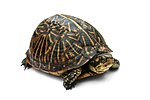Thermoregulation is the ability of an organism to keep its body temperature within certain boundaries, even when the surrounding temperature is very different...
55 KB (6,374 words) - 13:50, 22 October 2024
As in other mammals, human thermoregulation is an important aspect of homeostasis. In thermoregulation, body heat is generated mostly in the deep organs...
14 KB (1,840 words) - 21:55, 2 August 2024
Pinniped (redirect from Thermoregulation in pinnipeds)
Pinnipeds (pronounced /ˈpɪnɪˌpɛdz/), commonly known as seals, are a widely distributed and diverse clade of carnivorous, fin-footed, semiaquatic, mostly...
107 KB (12,603 words) - 11:38, 4 November 2024
Rabbit (redirect from Thermoregulation in rabbits)
detect potential predators. The ears of a rabbit are essential for thermoregulation and contain a high density of blood vessels. The bone structure of...
122 KB (12,688 words) - 13:09, 7 November 2024
Bat (redirect from Thermoregulation in bats)
water loss. Water helps maintain their ionic balance in their blood, thermoregulation system, and removal of wastes and toxins from the body via urine. They...
171 KB (18,309 words) - 04:18, 2 November 2024
Insect thermoregulation is the process whereby insects maintain body temperatures within certain boundaries. Insects have traditionally been considered...
16 KB (2,122 words) - 04:00, 19 June 2024
Turtle (section Thermoregulation)
Turtles are reptiles of the order Testudines, characterized by a special shell developed mainly from their ribs. Modern turtles are divided into two major...
129 KB (13,433 words) - 17:16, 5 November 2024
Homeothermy (category Thermoregulation)
Homeothermy, homothermy or homoiothermy is thermoregulation that maintains a stable internal body temperature regardless of external influence. This internal...
9 KB (1,043 words) - 20:34, 17 September 2024
Mesotherm (category Thermoregulation)
coined to advocate for an intermediate status of non-avian dinosaur thermoregulation, between endotherms and ectotherms. A more technical definition was...
7 KB (756 words) - 07:14, 6 October 2024
Black squirrel (section Thermoregulation)
that its frequency is the result of crypsis, and/or the result of thermoregulation. It has been theorized that non-melanistic gray squirrels have a concealment...
40 KB (4,495 words) - 07:31, 27 September 2024
keep the head clean when feeding, and also plays an important role in thermoregulation. Vultures have been observed to hunch their bodies and tuck in their...
25 KB (2,769 words) - 23:49, 29 October 2024
Warm-blooded (category Thermoregulation)
regulating metabolic processes. Other species have various degrees of thermoregulation. As there are more than two categories of temperature control utilized...
11 KB (1,231 words) - 07:49, 25 October 2024
Lazarus M, Saper CB (September 2009). "Parallel preoptic pathways for thermoregulation". The Journal of Neuroscience. 29 (38): 11954–64. doi:10.1523/JNEUROSCI...
50 KB (4,977 words) - 18:21, 31 August 2024
Mammal (section Thermoregulation)
in the spinal cord. The primary function of the fur of mammals is thermoregulation. Others include protection, sensory purposes, waterproofing, and camouflage...
222 KB (23,150 words) - 16:26, 6 November 2024
Hogna carolinensis (section Thermoregulation)
Hogna carolinensis, commonly known as the Carolina wolf spider and giant wolf spider, is found across North America. It is the largest of the wolf spiders...
20 KB (2,598 words) - 19:24, 21 June 2024
suspend central homeostasis, allowing large fluctuations in respiration, thermoregulation and circulation which do not occur in any other modes of sleeping or...
70 KB (8,446 words) - 16:20, 1 October 2024
Desert cottontail (section Thermoregulation)
desert cottontails make up 14% of their body size and may help with thermoregulation. Many desert animals prey on cottontails, including birds of prey,...
16 KB (1,775 words) - 23:34, 4 November 2024
Cathemerality (section Thermoregulation)
fraction of illuminated moon in relation to sunset and sunrise times. Thermoregulation has been said to be an adaptive response that enables cathemeral animals...
14 KB (1,598 words) - 22:26, 1 August 2024
Dimetrodon (section Thermoregulation)
used to stabilize its spine or to heat and cool its body as a form of thermoregulation. Some recent studies argue that the sail would have been ineffective...
83 KB (9,217 words) - 20:31, 4 November 2024
Common ostrich (section Thermoregulation)
adaptations for thermoregulation, such as altering their feathers. Common ostriches display a feather fluffing behavior that aids them in thermoregulation by regulating...
122 KB (13,388 words) - 04:49, 11 October 2024
Newt (section Thermoregulation)
cutaneous water permeability, but promotes increased cutaneous blood flow. Thermoregulation, in combination with seasonal acclimation, describes the major mechanisms...
36 KB (3,836 words) - 18:50, 24 October 2024
Skin temperature (section Thermoregulation)
Skin acts as both a medium and means for delivering mechanisms of thermoregulation, including insulation, sweating and control of blood flow. Skin tissue...
28 KB (3,243 words) - 13:50, 30 October 2024
Roadrunner (section Thermoregulation)
The roadrunners (genus Geococcyx), also known as chaparral birds or chaparral cocks, are two species of fast-running ground cuckoos with long tails and...
18 KB (1,715 words) - 21:48, 2 November 2024
Dryocampa rubicunda (section Thermoregulation)
Dryocampa rubicunda, the rosy maple moth, is a small North American moth in the family Saturniidae, also known as the great silk moths. It was first described...
16 KB (1,810 words) - 09:34, 4 November 2024
Shark (section Thermoregulation)
Sharks are a group of elasmobranch fish characterized by a cartilaginous skeleton, five to seven gill slits on the sides of the head, and pectoral fins...
143 KB (14,302 words) - 13:08, 6 November 2024
Bombus polaris (section Thermoregulation)
temperatures. B. polaris has a thicker coat of hair than most bees, utilizes thermoregulation, and makes insulated nests. Bombus polaris is part of the family Apidae...
15 KB (1,789 words) - 15:41, 17 March 2024
Spring peeper (section Thermoregulation)
The spring peeper (Pseudacris crucifer) is a small chorus frog widespread throughout the eastern United States and Canada. It prefers permanent ponds due...
38 KB (4,475 words) - 01:47, 15 October 2024
killed off much of the area's seagrass (and which would have also made thermoregulation difficult for the sloths, with their slow metabolism). Ground sloths...
50 KB (5,432 words) - 03:14, 21 October 2024
Kleptothermy (category Thermoregulation)
In biology, kleptothermy is any form of thermoregulation by which an animal shares in the metabolic thermogenesis of another animal. It may or may not...
17 KB (1,993 words) - 20:27, 7 November 2023
exposure to UV can damage health. Loss of body hair in Homo links to the thermoregulation through perspiration heat dissipation required for activity in hot...
129 KB (14,406 words) - 20:56, 26 October 2024
























